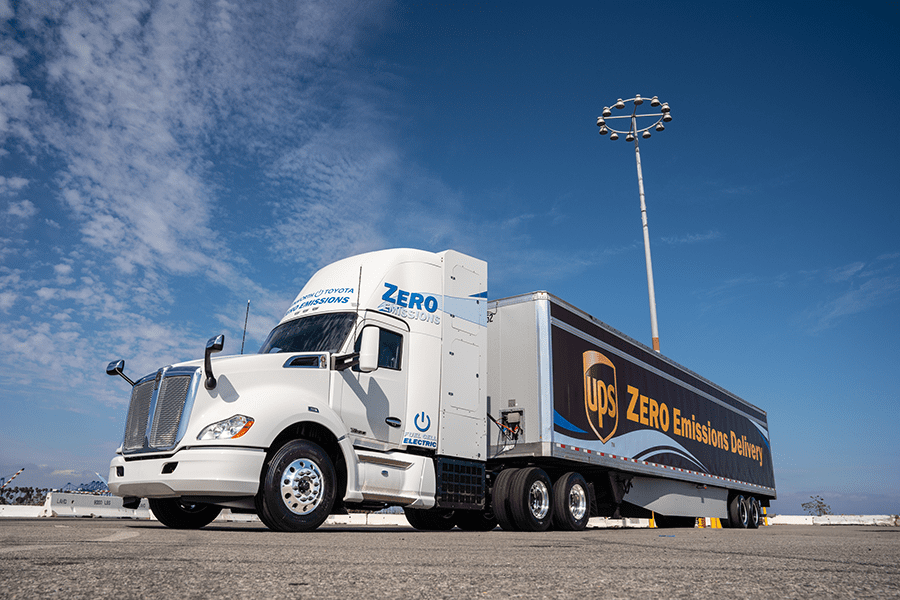Our economy is facing a profound transition to alternative energy technologies, spurred by the goal to combat climate change and unhealthy air by reducing greenhouse gas emissions and air pollutants. Across the globe, hydrogen and fuel cells are emerging as a solution for multiple sectors of our economy, such as transportation, energy, and industrial sectors. The International Energy Agency (IEA) recently released a report that identifies hydrogen and fuel cells as a key solution in the energy transition, highlighting four main recommendations where the technology is poised to initially flourish:
- Make industrial ports nerve centers for scaling up the use of clean hydrogen.
- Build on existing infrastructure, such as millions of kilometers of natural gas pipelines.
- Expand hydrogen in transport through fleets, freight, and corridors.
- Launch the hydrogen trade’s first international shipping routes.
Hydrogen Fuel Cell Vehicles Across Sectors
In recent years, the industry has focused heavily on the heavy-duty sector, with an effort to start deploying long-range, Class 8 fuel cell electric trucks (FCETs), like the vehicles Nikola Motor is developing, as well as the port drayage FCETs being developed by Toyota and Kenworth. Hyundai and Horizon Fuel Cells have also announced deployment plans for thousands of FCETs.
There are unique applications where using hydrogen fuel cells is the only zero emission solution, such as 24/7 operation of CHEs in ports.
There are also many unique applications where using hydrogen fuel cells is the only zero emission solution, such as 24/7 operation of container handling equipment (CHE) in ports. The heavy-duty sector is not new to the hydrogen fuel cell industry. For the past 20 years, manufacturers have integrated fuel cell technology into heavy-duty transit buses. Fuel cells have proven their potential in the transit sector as well, with the National Renewable Energy Laboratory (NREL) reporting over 30,000 hours of operation without needing to replace the fuel cell stacks, demonstrating the technology’s durability. Fuel cell electric buses (FCEBs) are a commercially viable option, with both New Flyer and El Dorado producing multiple bus models.
Light-duty has seen a number of successes as well with over 12,000 FCEVs on the road around the world and over 375 hydrogen refueling stations. The Honda Clarity, Toyota Mirai, and Hyundai Nexo customers are impressed by each vehicle’s excellent reliability and driver experience. With an increase in light-duty customers comes the increase in pressure for more hydrogen stations with greater reliability. Currently, California has 38 open retail hydrogen stations for over 7,400 drivers. California has reached the point where hydrogen vehicles are outpacing infrastructure for a variety of reasons. However, there is optimism, after the Northern California hydrogen shortage, that new stations will switch to liquid hydrogen, as True Zero has announced. This means more hydrogen capable of being stored onsite and a more robust hydrogen supply chain. Liquid hydrogen has a larger distribution radius and has been transported in the United States for more than half a century by multiple large suppliers, increasing overall competition.
Hydrogen Fuel Cell Use in Maritime Applications
The US, Norway, France, Germany, Netherlands, and the UK are all testing hydrogen fuel cell powered vessels.
The most recent revelation in the hydrogen and fuel cell industry is the use of fuel cells for maritime applications. The US, Norway, France, Germany, Netherlands, and the UK are all testing hydrogen fuel cell powered vessels. The momentum in this sector kicked off last year when Norway announced that by 2026 all cruise ships and ferries must operate with zero emissions in their fjords. Since then, the Norwegian government has put out multiple competitive funding opportunities for shipping companies to build zero emission ferries, by using both battery electric and fuel cell technology. In California, Golden Gate Zero Emission Marine (GGZEM) has the opportunity to be the first fuel cell ferry to actually hit the water. While there are over five hydrogen fuel cell vessels under construction in Europe, the first to be operational across the pond is expected early 2021. The GGZEM team, led by Dr. Joseph Pratt and based in Oakland, California, is aiming for early 2020 to get their Water-Go-Round fuel cell vessel underway on its maiden voyage.
What’s to Come for Hydrogen Fuel Cell Technology
The industry is optimistic that fuel cell vehicles will reach higher levels of market penetration.
Across multiple sectors, it is obvious that hydrogen fuel cells are making moves and achieving new milestones every day. At the same time, hydrogen infrastructure is under tremendous pressure to expand, increase reliability, and reach price parity with fossil fuels through economies of scale catalyzed by mass production. Additionally, public funding will have to play a continuing role in the effort to scale hydrogen, at least in the near term. The industry is optimistic that, as the world moves forward in the transition away from fossil fuels, fuel cell vehicles will reach higher levels of market penetration for both transportation and energy storage through continued investment in the development and deployment of hydrogen infrastructure.


